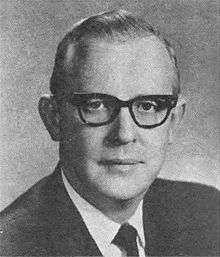James Franklin Battin
| James Franklin Battin | |
|---|---|
 | |
| Chief Judge of the United States District Court for the District of Montana | |
|
In office November 16, 1978 – February 13, 1990 | |
| Preceded by | Russell Evans Smith |
| Succeeded by | Paul G. Hatfield |
| Judge of the United States District Court for the District of Montana | |
|
In office February 27, 1969 – February 13, 1990 | |
| Nominated by | Richard Nixon |
| Preceded by | William James Jameson |
| Succeeded by | Jack D. Shanstrom |
| Member of the U.S. House of Representatives from Montana's 2nd district | |
|
In office January 3, 1961 – February 27, 1969 | |
| Preceded by | LeRoy H. Anderson |
| Succeeded by | John Melcher |
| Personal details | |
| Born |
February 13, 1925 Wichita, Kansas |
| Died |
September 27, 1996 (aged 71) Billings, Montana |
| Political party | Republican |
| Alma mater |
Eastern Montana College George Washington University Law School |
James Franklin Battin (February 13, 1925 – September 27, 1996) was a Republican U.S. Representative from the U.S. state of Montana, and later a United States federal judge.
Born in Wichita, Kansas, Battin moved with his parents to Montana in November 1929. He was educated in the public schools of Billings, then the third largest city in the state, graduating from high school there in 1942. He enlisted in the United States Navy and served for three years, two and a half years of which were in the Pacific theater of operations. He returned to his studies and graduated in 1948 from Eastern Montana College in Billings.
He received a J.D. from George Washington University Law School in 1951, and was in private practice of law in Washington, D.C. from 1951 to 1952, then in Billings from 1953 to 1960. He was a deputy county attorney of Yellowstone County, Montana from 1953 to 1955, then general counsel and secretary of the City-County Planning Board of Billings in 1955. In 1955 he became an assistant city attorney of Billings, and was the city attorney from 1957 to 1958. He served as member of the Montana House of Representatives in 1958 and 1959.
Battin was elected as a Republican to the Eighty-seventh and to the three succeeding Congresses, and served from January 3, 1961, until his resignation February 27, 1969, to become United States district judge. He was nominated by President Richard M. Nixon on February 20, 1969, to a seat on the United States District Court for the District of Montana vacated by William James Jameson. He was confirmed by the United States Senate on February 25, 1969, and received his commission on February 27, 1969.
He became chief judge of the District on November 16, 1978, and served as chief judge until 1990. He assumed senior status on February 13, 1990, and served in that capacity until his death, in Billings. The James F. Battin Courthouse in Billings is named for him. Battin lived long enough to see his son, Jim, elected to the California State Assembly in 1994 but did not live to see his son's two reelections to the Assembly nor his son's election to two terms in the California State Senate.
One of the cases that Battin handled was the conviction of four counts of extortion of the Louisiana Teamsters Union business agent Edward Grady Partin, the one who supplied the immunized testimony that sent Jimmy Hoffa to prison.[1]
References
- United States Congress. "James Franklin Battin (id: B000241)". Biographical Directory of the United States Congress.
- James Franklin Battin at the Biographical Directory of Federal Judges, a public domain publication of the Federal Judicial Center.
- ↑ "U.S. Court of Appeals: Cases and Opinions". cases.justia.com. Retrieved May 7, 2010.
![]() This article incorporates public domain material from the Biographical Directory of the United States Congress website http://bioguide.congress.gov.
This article incorporates public domain material from the Biographical Directory of the United States Congress website http://bioguide.congress.gov.
| United States House of Representatives | ||
|---|---|---|
| Preceded by LeRoy H. Anderson |
Member of the U.S. House of Representatives from Montana's 2nd congressional district 1961-1969 |
Succeeded by John Melcher |
| Legal offices | ||
| Preceded by William James Jameson |
Judge of the United States District Court for the District of Montana 1969–1990 |
Succeeded by Jack D. Shanstrom |
